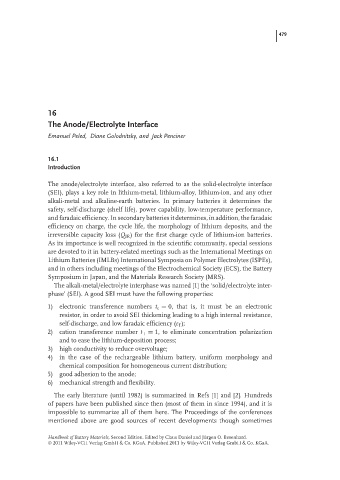Page 506 - Handbook of Battery Materials
P. 506
479
16
The Anode/Electrolyte Interface
Emanuel Peled, Diane Golodnitsky, and Jack Penciner
16.1
Introduction
The anode/electrolyte interface, also referred to as the solid-electrolyte interface
(SEI), plays a key role in lithium-metal, lithium-alloy, lithium-ion, and any other
alkali-metal and alkaline-earth batteries. In primary batteries it determines the
safety, self-discharge (shelf life), power capability, low-temperature performance,
and faradaic efficiency. In secondary batteries it determines, in addition, the faradaic
efficiency on charge, the cycle life, the morphology of lithium deposits, and the
irreversible capacity loss (Q IR ) for the first charge cycle of lithium-ion batteries.
As its importance is well recognized in the scientific community, special sessions
are devoted to it in battery-related meetings such as the International Meetings on
Lithium Batteries (IMLBs) International Symposia on Polymer Electrolytes (ISPEs),
and in others including meetings of the Electrochemical Society (ECS), the Battery
Symposium in Japan, and the Materials Research Society (MRS).
The alkali-metal/electrolyte interphase was named [1] the ‘solid/electrolyte inter-
phase’ (SEI). A good SEI must have the following properties:
1) electronic transference numbers t e = 0, that is, it must be an electronic
resistor, in order to avoid SEI thickening leading to a high internal resistance,
self-discharge, and low faradaic efficiency (ε f );
2) cation transference number t + = 1, to eliminate concentration polarization
and to ease the lithium-deposition process;
3) high conductivity to reduce overvoltage;
4) in the case of the rechargeable lithium battery, uniform morphology and
chemical composition for homogeneous current distribution;
5) good adhesion to the anode;
6) mechanical strength and flexibility.
The early literature (until 1982) is summarized in Refs [1] and [2]. Hundreds
of papers have been published since then (most of them in since 1994), and it is
impossible to summarize all of them here. The Proceedings of the conferences
mentioned above are good sources of recent developments though sometimes
Handbook of Battery Materials, Second Edition. Edited by Claus Daniel and J¨ urgen O. Besenhard.
2011 Wiley-VCH Verlag GmbH & Co. KGaA. Published 2011 by Wiley-VCH Verlag GmbH & Co. KGaA.

